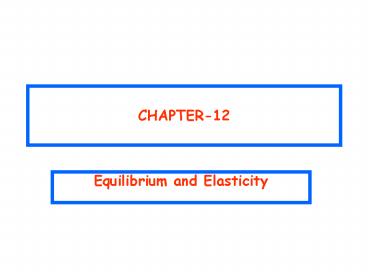Equilibrium and Elasticity PowerPoint PPT Presentation
1 / 8
Title: Equilibrium and Elasticity
1
CHAPTER-12
- Equilibrium and Elasticity
2
Ch 12-2 Equilibrium
- A body is said to be in equilibrium if
- i) Translational equilibrium
- Fnetdp/dt 0 pmvconstant vconstant
- ii) Rotational equilibrium
- ?net dl/dt 0 lI?0 ? constant
- Zero and Non-Zero constant values of v and ?
- 1) Static equilibrium
- v ?0 Fnet ?net0
- 2) Dynamical equilibrium
- v ??0 Fnet ?net0
3
Ch 12-3 Requirement of Static Equilibrium
- For static equilibrium of a rigid body
- i) ?Fext0
- ii) ??ext0
- iii) P?pi0
4
Ch 12-2 Center of Gravity
- Center of gravity (cog) of a body is a point
where gravitational force Fg effectively acts on
a body. - For a constant value of g for all elements of
body com and cog coincides
5
Sample Problem 12-1
- A uniform beam and a block is resting on two
scales. What do the scales read? - Draw FBD
- Solve for two conditions of static equilibriums
- 1) ?F0 and ??0
- ?FFlFr-Mg-mg0
- 2) Taking the moment about the point of action of
Fl - ??FrxL-mgx(L/2)-Mgx(L/4)0
- Fr-mg/2-Mg/40
- Frmg/2Mg/4
- FlFr-Mg-mg0
- Fl Mgmg- Fr
6
Ch 12-7 Elasticity
- A rigid body is said to be elastic if we can
change its dimension by pulling, pushing,
twisting, or compressing them - Stress deforming force per unit area
- Strain fractional change in dimension
- Tensile stress associated with stretching
- Shearing Stress associated with a force
surface area - Hydraulic stress from a fluid on an immersed
object to shrink its volume by an amount ?V
7
Ch 12-7 Elasticity
- Over linear (elastic range) Stressmodulus x
strain - For further increase in stress beyond yield
strength Sy of the specimen, the specimen becomes
permanently deformed - For additional increase in stress beyond yield
strenth Sy, the specimen eventually rupture at
ultimate strengthSu
8
Ch 12-7 Elasticity
- Tension and Compression For simple tension or
compression the stress is force F/area A (?to the
direction of application of force). The strain is
fractional change ?L/L in the length of specimen. - The modulus of for tensile and compressive
stresses is called the Young modulus E (F/A)/
(?L/L) - Shearing , the shearing stress force F/area A
(to the direction of application of force). The
strain is fractional change ?x/L in the length of
specimen.Shear modulus G (F/A)/ (?x/L) - Hydraulic Stress
- For Hydraulic Stress the stress is fluid pressure
p (force F/area A ) The strain is fractional
change in volume ?V/V. - The modulus of for hydraulic stresses the Bulk
modulus B p/(?V/V)

